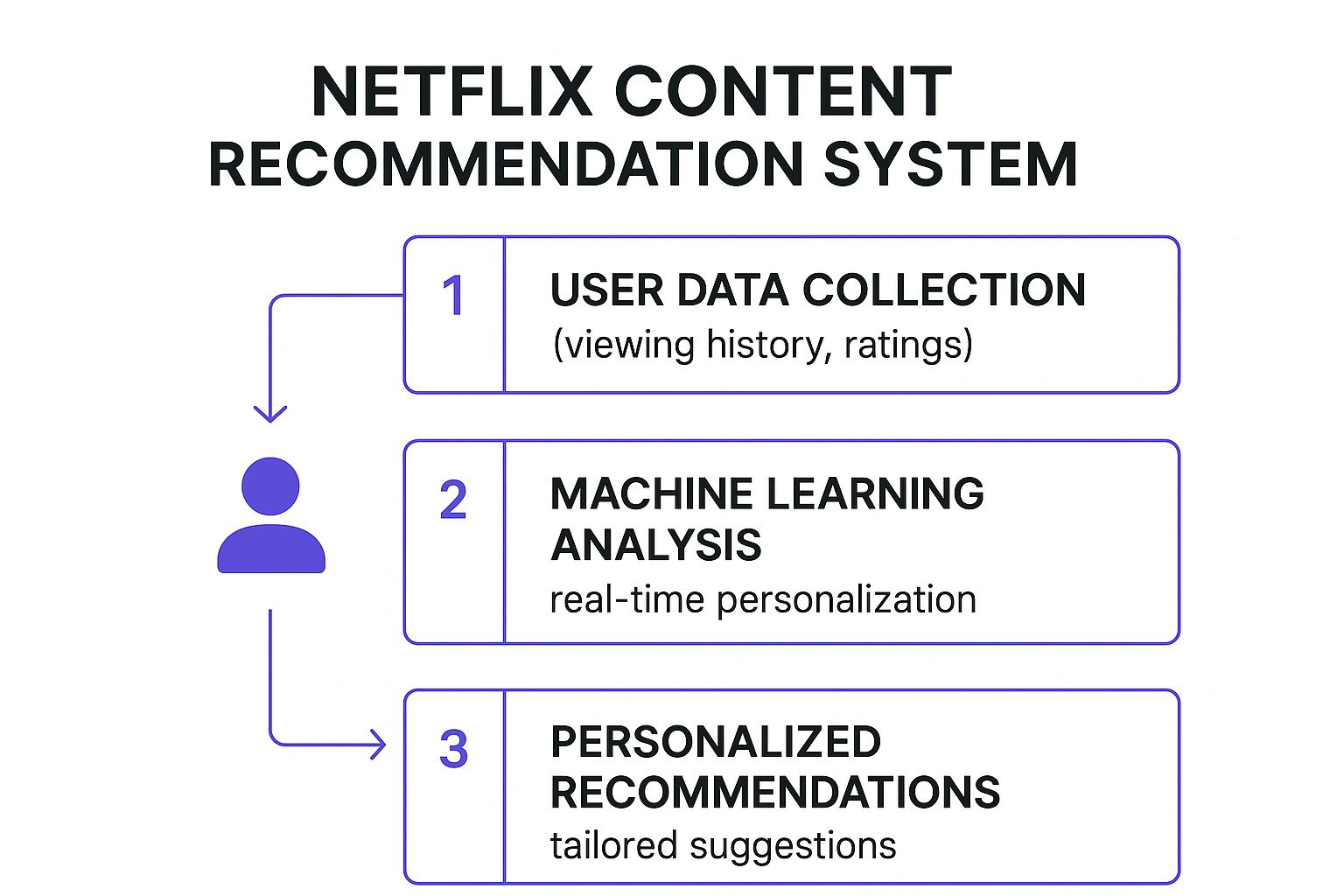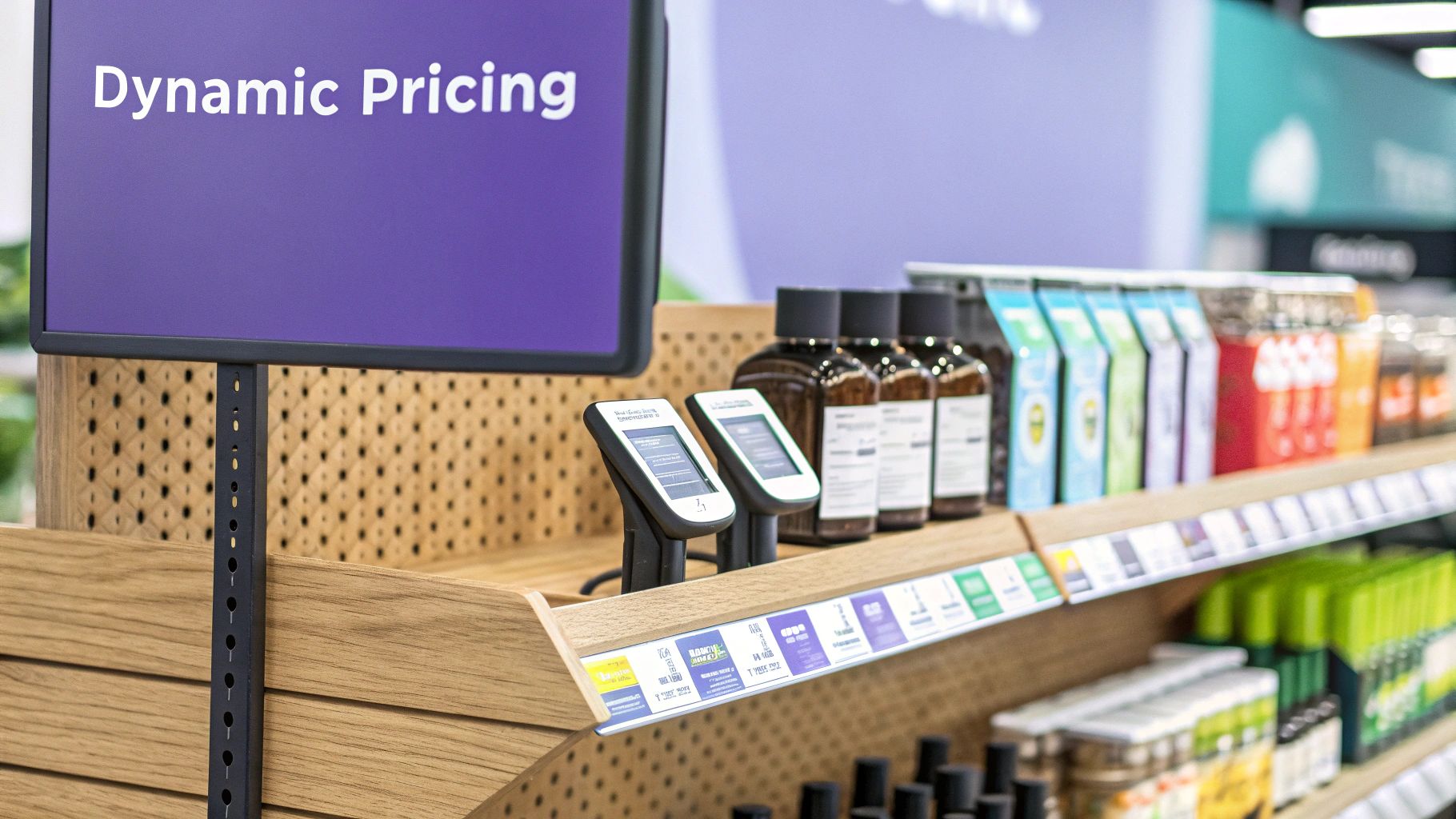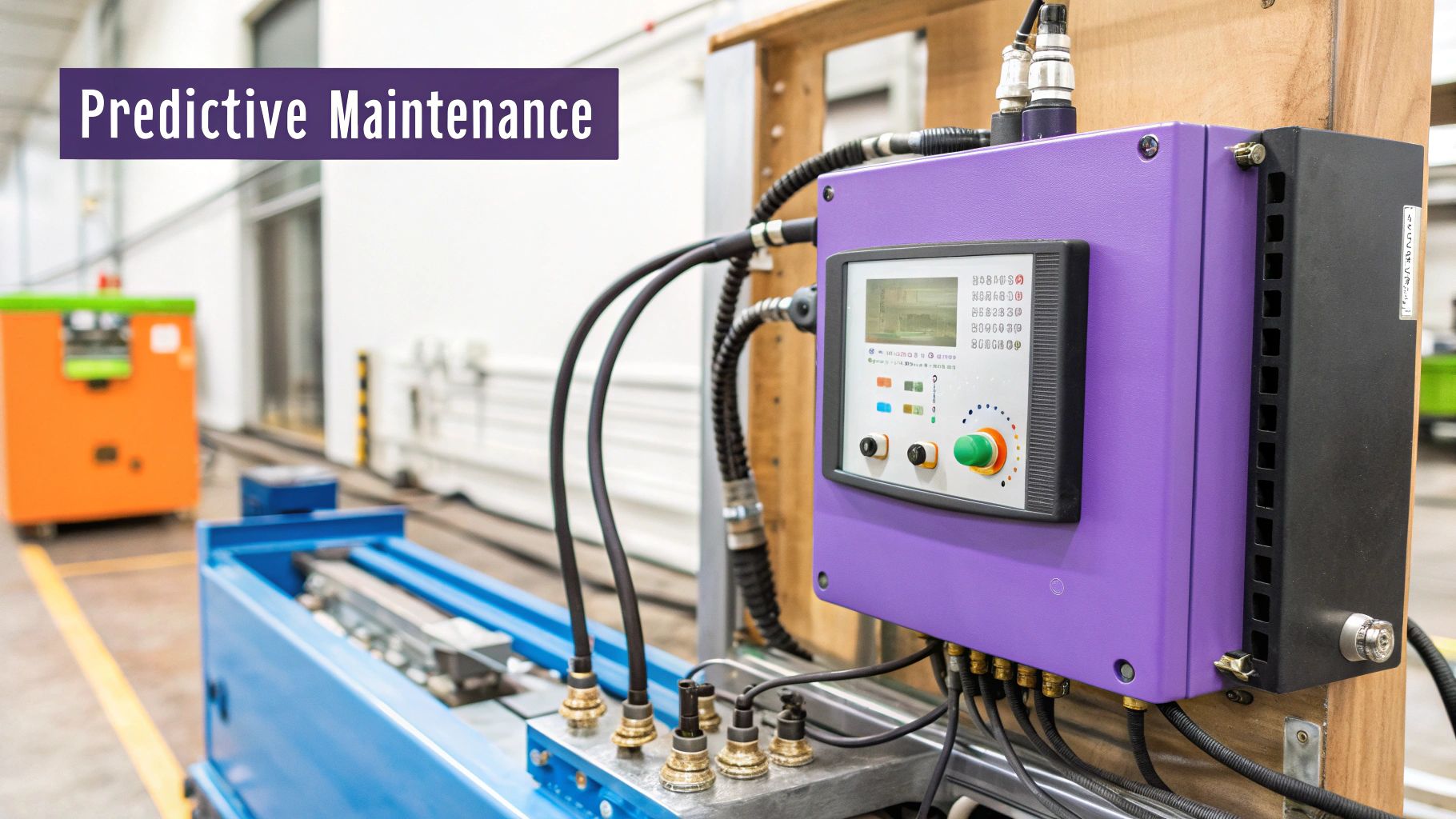
From forecasting customer behavior to preventing equipment failure, predictive analytics has become an essential strategic asset for modern businesses. By analyzing historical and real-time data to identify patterns and predict future outcomes, organizations can move from reactive problem-solving to proactive, data-driven decision-making. This shift fundamentally changes how companies operate, compete, and deliver value. The advancements in this field are powered by a suite of cutting-edge technologies, including leading AI tools for research that enable sophisticated model development.
This article moves beyond theory to provide a deep dive into powerful, real-world examples of predictive analytics in action. We will dissect the strategies used by industry leaders like Netflix, Amazon, and others, breaking down not just what they do but how they do it.
You will gain a clear understanding of:
Each example is structured to offer practical insights and replicable methods, equipping you with the knowledge to apply these powerful techniques in your own organization, whether your focus is on customer retention, operational efficiency, or financial risk management.
Netflix's recommendation engine is a cornerstone of its business model and a prime example of predictive analytics in action. The system goes far beyond simple suggestions, using sophisticated machine learning algorithms to analyze a massive trove of user data. This includes not just explicit signals like ratings but also implicit behaviors such as viewing history, search queries, time of day, device used, and even how long a user pauses on a specific title card.
By processing billions of these data points, Netflix predicts which movies and shows a specific user is most likely to watch and enjoy. This predictive power is so effective that the company reports over 80% of all content streamed on the platform is driven by its recommendations. This directly impacts user retention by minimizing content discovery friction and maximizing engagement.
Netflix’s success is rooted in its deep, multi-layered approach to personalization. The algorithm doesn’t just match users to content; it tailors the entire presentation. For example, the system performs A/B testing on thumbnail images, showing different artwork to various user segments to see which one drives more clicks. A user who enjoys romantic comedies might see a thumbnail of a film's lead couple, while someone who watches more action films might see an image from an explosion scene from that same movie.
Key Takeaway: The goal isn't just to predict what a user will like, but to predict how to best present that content to them. This level of granular personalization creates a highly sticky user experience.
The following diagram illustrates the simplified process flow of how Netflix transforms user data into personalized content suggestions.

This process highlights a continuous feedback loop where every user action refines the machine learning model, ensuring recommendations become increasingly accurate over time.
For businesses looking to implement similar predictive models, the key is to start small and iterate.
Amazon's dynamic pricing engine is one of the most powerful and widely recognized examples of predictive analytics in e-commerce. The system automates price adjustments for millions of products in real-time, leveraging machine learning to process a vast array of variables. This includes competitor pricing, inventory levels, historical sales data, demand forecasts, seasonal trends, and even individual customer behavior patterns.

By analyzing these inputs, Amazon's algorithms predict the optimal price point for a product at any given moment to maximize profitability while remaining competitive. This allows the retail giant to respond instantly to market fluctuations, such as a competitor's sale or a sudden surge in demand for a specific item, reportedly changing prices on over 15% of its catalog daily. This agility is a key driver of its market dominance and revenue optimization.
Amazon's strategy is built on surgically precise, data-driven price adjustments that balance multiple business objectives. The system doesn't just aim for the lowest price; it predicts the price that will yield the highest conversion rate and profit margin. For instance, during its Prime Day sales event, prices are not arbitrarily slashed. Instead, they are optimized based on predictive demand models that forecast which deals will generate the most traffic and "halo effect" sales on other products.
This predictive capability also extends to identifying when to raise prices. If a competitor runs out of stock on a popular electronic device, Amazon’s system can predict the resulting increase in demand on its own platform and adjust the price upward accordingly, capturing additional profit.
Key Takeaway: Effective dynamic pricing isn't about a race to the bottom. It's about using predictive models to understand price elasticity and market context to find the most profitable price point at any given second.
For businesses aiming to leverage predictive pricing, the approach should be methodical and controlled to avoid alienating customers or sparking destructive price wars.
Predictive maintenance represents a paradigm shift from reactive ("fix it when it breaks") or preventive ("fix it on a schedule") maintenance to a proactive, data-driven strategy. This is one of the most impactful examples of predictive analytics in the industrial sector. It uses data from IoT sensors, historical performance logs, and machine learning models to forecast equipment failures before they occur. By analyzing real-time data streams like vibration, temperature, and pressure, algorithms can detect subtle anomalies that signal an impending breakdown.
This foresight allows companies to schedule repairs during planned downtime, avoiding costly, catastrophic failures and significantly extending the lifespan of critical machinery. Leaders in this space include Rolls-Royce, which monitors its aircraft engines in real-time, and Siemens, which applies predictive models to its massive wind turbines to ensure consistent energy generation.

The true value of predictive maintenance is its ability to transform a cost center (maintenance) into a source of operational efficiency and competitive advantage. The models don't just predict a binary "fail" or "not fail" state. They provide a Remaining Useful Life (RUL) estimate for specific components, allowing for precise, just-in-time servicing. This optimizes inventory for spare parts, reduces labor costs, and maximizes equipment uptime, which directly translates to increased production output.
Key Takeaway: The goal is to move beyond simple failure alerts to a holistic understanding of equipment health. This enables a strategic approach to asset management, optimizing maintenance schedules and resource allocation for maximum financial impact.
The diagram above illustrates how raw sensor data is transformed into actionable intelligence, creating a continuous improvement cycle where each maintenance event refines the predictive accuracy of the underlying model.
For industrial businesses aiming to implement a predictive maintenance program, a phased approach is crucial for success.
In healthcare, predictive analytics is revolutionizing patient care by forecasting health outcomes and identifying at-risk individuals before a crisis occurs. This is one of the most impactful examples of predictive analytics, shifting medicine from a reactive to a proactive model. Systems analyze vast datasets, including electronic health records (EHRs), lab results, genomic data, and even wearable device information, to uncover subtle patterns that signal potential health issues like heart failure, sepsis, or diabetes.
By identifying these patterns, healthcare providers can intervene earlier, personalize treatment plans, and allocate resources more effectively. For instance, Epic Systems' sepsis prediction model, integrated into many hospital EHRs, has been shown to reduce mortality rates by flagging at-risk patients hours earlier than traditional methods. Similarly, models developed by institutions like the Cleveland Clinic can predict the likelihood of hospital readmission, allowing care teams to implement post-discharge support for high-risk patients.
The true power of predictive analytics in healthcare lies in its ability to augment clinical judgment, not replace it. These models act as an early warning system, drawing a clinician's attention to patients who may not yet display obvious symptoms. For example, Google's DeepMind developed an algorithm that can detect diabetic retinopathy, a leading cause of blindness, by analyzing retinal scans with an accuracy rivaling that of ophthalmologists. This enables earlier detection and treatment, especially in underserved areas.
Key Takeaway: The strategic goal is not just to predict disease, but to integrate these predictions seamlessly into clinical workflows. Success depends on delivering timely, actionable alerts to care providers in a way that supports their decision-making process without causing alert fatigue.
This approach transforms massive amounts of passive health data into an active tool for preventive care. It allows for a more personalized and efficient healthcare system, ultimately improving patient outcomes and reducing costs associated with emergency interventions and chronic disease management.
For healthcare organizations aiming to leverage predictive analytics, a phased and ethically grounded approach is essential.
Predicting credit risk is a foundational use case for predictive analytics in the financial sector. Instead of relying solely on historical credit scores, modern financial institutions use predictive models to analyze hundreds or even thousands of variables for each loan applicant. These models assess the probability of a borrower defaulting on a loan by examining data points like income stability, debt-to-income ratio, transaction history, and employment longevity.
Companies like Upstart and Zest AI have pushed this even further, incorporating alternative data sources such as education level, utility payment history, and even rent payments. This application of predictive analytics has revolutionized lending by enabling more accurate risk pricing and extending credit access to individuals with limited traditional credit histories, a demographic often underserved by legacy systems.
The core strategy here is to move beyond simple correlation to a sophisticated, multi-dimensional understanding of risk. Where a traditional FICO score might penalize a person for having a thin credit file, a predictive model can identify positive financial habits from alternative data, painting a more holistic picture of their creditworthiness. For example, a platform like Upstart might approve a recent graduate with high earning potential but a short credit history, a scenario traditional models would often reject.
Key Takeaway: The goal is not just to identify bad borrowers but to accurately identify good borrowers who are overlooked by traditional scoring methods. This creates a competitive advantage by unlocking new, creditworthy customer segments.
This advanced assessment allows lenders to offer more personalized loan terms. By precisely quantifying risk, they can adjust interest rates and loan amounts with greater confidence, reducing default rates while simultaneously expanding their market share.
For businesses in lending or finance, implementing robust credit risk models is crucial for growth and stability.
Effective inventory management is the lifeblood of retail, and predictive analytics has become an indispensable tool for optimizing it. Retailers leverage predictive models to forecast product demand, prevent stockouts, and reduce overstock scenarios, directly impacting profitability. These systems analyze vast datasets, including historical sales, seasonality, weather forecasts, marketing promotions, and even macroeconomic trends to predict what customers will buy and when.
Giants like Walmart showcase the scale of these operations, forecasting demand for over 100 million unique product-store combinations. Similarly, fast-fashion retailer Zara uses predictive analytics to align its rapid production cycles with fleeting trends, ensuring new items arrive in stores precisely when demand peaks. This analytical prowess is a core reason why these companies are powerful examples of predictive analytics in the retail sector, turning data into a significant competitive advantage.
The true power of retail predictive analytics lies in its granularity. Modern systems move beyond simple historical sales trends to incorporate a complex web of external variables. For instance, a model might predict a surge in demand for raincoats at a specific Home Depot location by correlating a 7-day weather forecast with local event schedules. It can also anticipate the "halo effect" of a promotion, predicting how a discount on one item might lift sales of related, non-discounted products.
This level of detail allows for proactive inventory allocation rather than reactive stock replenishment. By anticipating demand spikes, retailers can pre-position inventory in regional distribution centers, ensuring products are available on shelves without costly expedited shipping or lost sales from stockouts.
Key Takeaway: The goal is to shift from a "just-in-case" inventory strategy, which is capital-intensive, to a "just-in-time" model driven by accurate demand predictions. This minimizes holding costs and maximizes sales opportunities.
Businesses can adopt predictive forecasting by following a structured, iterative approach.
Financial institutions and e-commerce giants use predictive analytics as their primary defense against fraudulent activity. These sophisticated systems operate in real-time, analyzing thousands of data points for every single transaction to flag anomalies. The models evaluate variables like transaction amount, time of day, geographic location, device fingerprint, and the user's historical behavior to calculate a risk score. This is one of the most critical real-time examples of predictive analytics, with platforms like PayPal and Mastercard's Decision Intelligence processing billions of events to prevent financial losses.
By building a comprehensive profile of normal customer behavior, the algorithms can instantly spot deviations that indicate a compromised account or stolen payment information. For instance, a transaction originating from a new device in an unusual country would immediately raise a red flag. These systems continuously learn from new fraud tactics, allowing them to adapt to evolving threats and protect both the business and its customers from sophisticated schemes.
The true power of modern fraud detection lies in its ability to combine speed with high accuracy, minimizing friction for legitimate customers. Systems like the FICO Falcon Fraud Manager, used by over 9,000 organizations, achieve this by using ensemble modeling, which combines the outputs of several different machine learning algorithms. One model might be excellent at detecting unusual spending patterns, while another specializes in identifying compromised devices.
By blending these different predictive strengths, the system can make a more nuanced and reliable decision. This reduces the number of "false positives" where a legitimate transaction is incorrectly blocked, which is a major source of customer frustration. The goal is to create a seamless security layer that is nearly invisible to genuine users but forms an impenetrable barrier for fraudsters.
Key Takeaway: Effective fraud prevention isn't about blocking every suspicious transaction. It's about accurately predicting the probability of fraud and intervening only when necessary, thus preserving a positive customer experience.
For any business handling transactions, implementing a predictive fraud system is crucial for scaling securely.
As we’ve explored through these detailed examples of predictive analytics, the power to anticipate the future is no longer a futuristic concept; it's a present-day competitive necessity. From Netflix's content personalization to the life-saving potential of predictive diagnostics in healthcare, the applications are as diverse as they are transformative. We’ve moved beyond simply collecting data to actively using it to forecast outcomes, mitigate risks, and seize opportunities before they fully materialize.
The core lesson from these use cases is that predictive analytics is not just an IT function. It is a strategic business capability that must be woven into the very fabric of an organization. Success isn't just about having the right algorithms; it's about asking the right questions, preparing your data infrastructure, and building a culture that trusts and acts on data-driven insights.
The journey from data-rich to insight-driven requires a clear-eyed strategy. The most successful implementations share common threads you can replicate:
Key Insight: The ultimate goal is to close the loop between prediction and action. Your analytics strategy should be designed not just to create forecasts, but to embed those forecasts into the operational workflows where decisions are made every day.
Embarking on this journey can feel daunting, but it can be broken down into manageable steps.
By moving from abstract interest to a concrete, strategic plan, you can begin to harness the profound power we’ve detailed. Mastering predictive analytics allows you to stop reacting to the past and start shaping your future, creating a more efficient, profitable, and resilient organization.
Ready to move from theory to practice? Statisfy provides the tools and expertise to implement powerful predictive models without the steep learning curve, helping you operationalize insights and drive real business outcomes. Discover how our platform can help you build your own success story based on these powerful examples of predictive analytics at Statisfy.